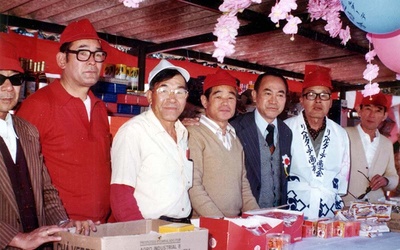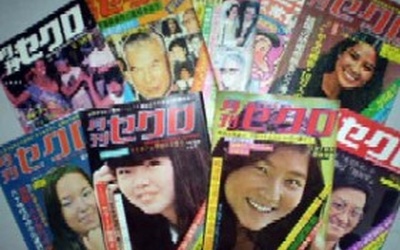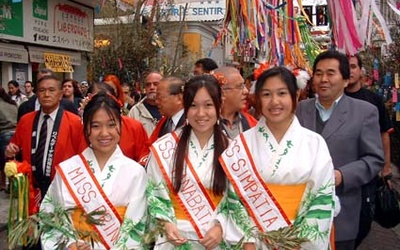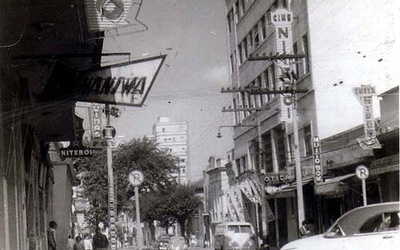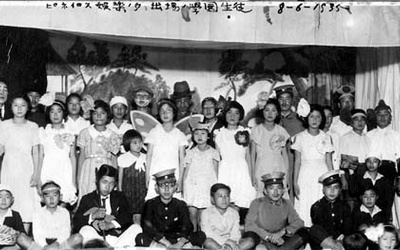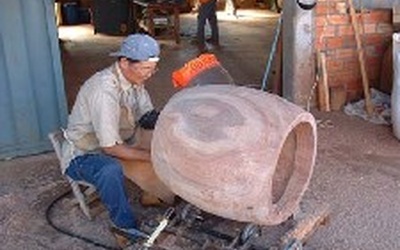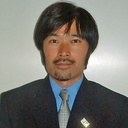
Sachio Negawa
Sachio Negawa is an assistant professor in the departments of Translations and Foreign Languages at the University of Brasília. An expert on Immigration History and Cultural Comparative Studies, he has lived in Brazil since 1996. He has fully dedicated himself to the study of learning institutions in Japanese and other Asian communities.
Last Updated March 2007
Stories from This Author
第11回 東洋街形成と一世リーダーたち(1) -田中義数-
Feb. 21, 2008 • Sachio Negawa
世界のどの移民史の局面でも、エスニックタウン形成の初期には、強力な指導力をもった大物リーダーが存在した。サンパウロ東洋街創設にかかわった日系大物リーダーといえば、まず思い浮かぶのが田中義数(1909~1979)と水本毅(1920~1989)であろう。 すでに書いたように(第6回「東洋街の形成と発展①」)、1953年、シネ・ニテロイがリベルダーデ広場からガルヴォン・ブエノ通りを少し下ったと ころ(現在の大阪橋の位置)に開業したことによって(写真11-1)、このエリアに日…
Chapter 10 (extras: part 2) Londrina – The Nikkei Cultural Movement & The Matsuri Dance
Jan. 10, 2008 • Sachio Negawa
Recently in Brazil, terms such as “Nikkei culture” and “Shin (new) Nikkei culture” have become popular to use, especially among the Japanese-language papers. These terms are used to describe a “culture based upon ‘Japanese culture’ with a Brazilian-style influence.” This shows that there is a conscious differentiation between the “Japanese culture of Japan” and the “Japanese culture of Brazil,” defining the latter as a “Nikkei culture” that is a part of the multicultural “Brazilian culture.” Currently, the area that is …
Chapter 9 The Formation and Development of Bairro Oriental (4) - Japanese Businesses Enter Into the Brazilian Market -
Nov. 2, 2007 • Sachio Negawa
Tomás de Gonzada Street in the mid-1970s: flashy neon lights, Japanese men drunkenly staggering and stumbling out of a club entrance, and the lovely voices of hostesses, with heavy make-up, waving goodbye. With sundown, Oriental town would transform itself into an amusement quarters. As mentioned before, there were three factors in the re-gathering of the Nikkei population and constructing of Oriental town in post-war Liberdade District. These included 1) the establishment of the Cine Niterói in 1953, 2) the founding …
Chapter 8: The Formation and Development of Bairro Oriental (3) - The Emergence of a New “Tradition”
Oct. 11, 2007 • Sachio Negawa
On the weekends, Bairro Oriental (Oriental town) turns into a bustling neighborhood filled with visitors and cars (Photo 8-1). The crowd is mainly made up of tourists, shoppers at the Asian supermarkets, diners at the various Japanese, Chinese, and Korean restaurants, and the young J-pop fans hanging out around the entrance of the station. Further, this area is the center of ethnic events such as the Flower Festival (Hana Matsuri) in April, the Tanabata Festival in July, and the Ōmisoka Mochi …
Chapter 7 The Formation and Development of Bairro Oriental (2) -The Establishment of the Liberdade Subway Station-
Sept. 6, 2007 • Sachio Negawa
Galvão Bueno Street in the Liberdade District of São Paulo was once said to be "in the day, as quiet as the night;" when Cine Niterói and three other movie theaters began business in the district in the early 1950s, it suddenly became a bustling area lit up with neon lights. By 1964, building was completed for the São Paulo Bunka Kyokai (São Paulo Culture Association, which later became known as the Brazil Nihon Bunka Kyokai, or Brazilian-Japanese Culture Association), …
Chapter 6: The Formation and Development of Bairro Oriental (1) : The Birth of Cine Niterói and Bunkyô
Aug. 9, 2007 • Sachio Negawa
Exiting out of Libertade station on the São Paulo South-North subway line, one arrives in a neighborhood filled with extravagant restaurant billboards and supermarkets selling Japanese, Chinese, and Korea products and ingredients. This is the center of Bairro Oriental, Libertade Plaza (Photo 6-1). Galvão Bueno Street runs south from here and at night, the street is lit up with the neon signs of shops along with the red Suzuran lamps. Once known as the largest Japantown in the world, Bairro …
Chapter 5 Pinheiros District - The Setting Sun of a Japantown
June 7, 2007 • Sachio Negawa
In and around São Paulo city, there are many areas referred to as “Japantowns.” Before and after World War II, the area known as the “Conde District” was the largest of the Japantowns. The Pinheiros Region followed in Nikkei population with around 200 Nikkei residents (Hanada, 1970, p.573). And after that, the area around the Municipal Central Market, which was named “Cantareira-gai” after the street (Reference Map 5-1). The Pinheiros District is around 7km from the city center and from …
Chapter 4 (Auxiliary Chapter) Yguazú Colony - A Community of Craftsmen
May 17, 2007 • Sachio Negawa
From January to February of 2007, I took a trip through Paraguay and the northern region of Paraná. Though the main goal of this series is to bring to light the history and current state of Japantowns in Brazil, in this auxiliary chapter, I would like to include my own impressions of the Nikkei colony of Yguazú from my visit. Foz do Iguaçu, famous for the Iguazu falls, is connected to Paraguay by a single bridge over the Paraná River. Once …
Chapter 3: The Conde District - Brazil’s First Japantown - 3) The Storm of War and the Chaotic Aftermath
April 27, 2007 • Sachio Negawa
Even after the Taishō Elementary School, Brazil’s first Nikkei schooling system, moved to San Joaquin Street, the Japantown of the Conde District continued to grow. It is believed that its most prosperous days were between the mid-1930s and around 1940. The Japanese community in São Paulo city at this time had risen out of the bleak years of 1914-15. The residents of Conde had “climbed up the hill,” reaching the height of the Conselheiro Furtado era, and advanced to Conde …
Chapter 2: The Conde District - Brazil’s First Japantown - 2) The Birth of Taishō Elementary School
April 5, 2007 • Sachio Negawa
Because Japanese community groups and parent’s associations provided the foundation for the management of many of the Nikkei school systems before the war, it was natural for these schools to be established in areas with large Nikkei populations. Here, I would like to provide a general overview of the Taishō Elementary School which was established in the Conde District (Reference Map 2, 3, 4), the first Japantown in Brazil, and the circumstances of those days. The Taishō Elementary School was …

